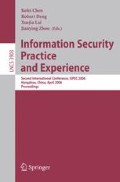Abstract
The past research works have explored the effectiveness of machine learning classifiers for filtering spam email, and the results have shown that machine learning classifiers can obtain a high degree of precision and recall. However, these methods cannot avoid classifying normal mail as spam mail for probability characteristics. The evident difference between spam mail and normal mail is that one spam mail will be delivered to many users, while most normal mails have only one single receiver. Based on this observation, this paper presents a server-based massive mail classifier incorporating counting-based classifier, bitmap-based white list (BWL) and grey list to filter massive spam mails. Results show that the spam mail classifier using our method can filter spam with a very low degree of false positive and also preserves performance while coping with large volumes of spam mail. With optimized parameter configuration, our method achieves a precision of 100% and recall of 75.3% in spam mail classification.
Access this chapter
Tax calculation will be finalised at checkout
Purchases are for personal use only
Preview
Unable to display preview. Download preview PDF.
References
Paul, N.C., Monitor, C.S.: New strategies aimed at blocking spam e-mail, http://newsobserver.com/24hour-/technology/story/655215p-4921708c.html
Nelson, M.: Anti-spam for business and isps: Market size 2003-2008. Ferris research - analyzer information service report (2003)
Fallows, D.: Spam: How it is hurting e-mail and degrading life on the internet Tech. Rep. 1100, PEW Internet & American Life Project (2003)
Harris, E.: The next step in the spam control war: Greylisting (2003), http://projects.puremagic.com/greylisting/
Cohen, W.W., Singer, Y.: Context-sensitive learning methods for text categorization. In: Proc. of 19th ACM International conference on Research and Development in Information Reterival (1996)
Gabber, E., Jakobsson, M., Matias, Y., Mayer, A.: Curbing Junk E-Mail via Secure Classification. Financial Cryptography (1998)
Sahami, M., Dumais, S., Hecherman, D., Horvitz, E.: A Bayesian Approach to Filtering Junk E-Mail. AAAI Tech. Rep. WS-98-05 (1998)
Androutsopoulos, I., Koutsias, J., Chandrinos, K.V., Paliouras, G., Spyropoulos, C.D.: An Evaluation of Naïve Bayesian Anti-Spam Filtering. In: Proc. of Workshop on Machine Learning in the New Information Age, 11th European Conference on Machine Learning, Barcelona (2000)
Iooannidis, J.: Fighting Spam by Encapsulating Policy in Email Addressed. In: 10th Network and Distributed System Security Symposium (2003)
Postel, J.B.: Simple Mail Transfer Protocol, http://www.faqs.org/rfcs/rfc821.html
Aho, A.V., Corasick, M.J.: Efficient string matching: an aid to bibliographic search. Communications of the ACM 18(6), 333–340 (1975)
Apache SpamAssassin Project. http://spamassassin.apache.org/
Author information
Authors and Affiliations
Editor information
Editors and Affiliations
Rights and permissions
Copyright information
© 2006 Springer-Verlag Berlin Heidelberg
About this paper
Cite this paper
Luo, H., Fang, B., Yun, X. (2006). A Counting-Based Method for Massive Spam Mail Classification. In: Chen, K., Deng, R., Lai, X., Zhou, J. (eds) Information Security Practice and Experience. ISPEC 2006. Lecture Notes in Computer Science, vol 3903. Springer, Berlin, Heidelberg. https://doi.org/10.1007/11689522_5
Download citation
DOI: https://doi.org/10.1007/11689522_5
Publisher Name: Springer, Berlin, Heidelberg
Print ISBN: 978-3-540-33052-3
Online ISBN: 978-3-540-33058-5
eBook Packages: Computer ScienceComputer Science (R0)

